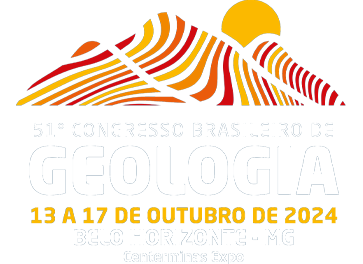Dados da Submissão
Título
BORRACHUDOS PEGMATITE IN THE GUANHÃES BASEMENT INLIER: GEOCHEMISTRY, ZIRCON U-Pb AGES AND Lu-Hf ISOTOPES
Texto do resumo
The Guanhães Basement Inlier (GBI), which is exposed in the central part of Minas Gerais, is characterized by the presence of a substantial amount of Statherian anorogenic granitic plutons, rhyolites, and subordinate basalts (Borrachudos Suite), which are tectonically juxtaposed to Archean gneisses and Paleoproterozoic metasedimentary rocks. The GBI was reworked during the Araçuaí orogeny that generated the pegmatite bodies of the Eastern Brazilian Pegmatite Province during the late to post-tectonic phases of the orogen (630 to 480 Ma). In an abandoned quarry located south of the city of Guanhães, where ornamental granites of the Borrachudos Suite were once exploited, pegmatite dykes cross-cut the magmatic foliation of stratiform coarse and medium-grained granites. Three samples were selected for geochemical analysis: coarse-grained granite, medium-grained granite, and the pegmatite. In all samples, the mineralogical composition remains consistent, featuring quartz, microcline, hornblende, biotite, and plagioclase, although in slightly varying proportions. The major elemental compositions of the three samples are as follows: SiO2 (71.38–75.64%), MgO (0.18–0.44%), CaO (0.60–2.55%), K2O (1.72–5.36%), Na2O (3.08–5.04%), Fe2O3(t) (2.71–5.07%), Al2O3 (10.4–13.8%). All samples exhibit metaluminous characteristics with A/CNK values ranging from 0.89 to 0.99 and A/NK > 1.08. The country rocks are classified as ferroan alkali-calcic granites, while the pegmatite is classified as ferroan calc-alkali to calcic. Trace elements were used to produce the tectonic classification diagrams in which all samples plot in the field of intraplate granites. Based on the REE diagram normalized to chondrite, the pegmatite exhibits a different fractionation pattern compared to the granites. Although all samples show enrichment of LREE relative to HREE, the (La/Yb)N ratio of the pegmatite is 1.72, while the ratios for the granites are significantly higher (coarse-grained = 14.76 and medium-grained = 16.36). Negative Eu anomalies are present in all samples. The pegmatite was selected for U-Pb LA-ICP-MS dating in zircon and yields concordant age of 1725 ± 5 Ma, interpreted as crystallization age. Metamorphic rims were identified in BSE images and yielded a weighted mean 206Pb/238U age of 506 ± 4 Ma. Lu-Hf isotopic analysis in zircon showed that the pegmatite has negative ƐHf values (-17.4 to -14.1) and TDM(Hf) ages vary between 3.01 and 3.18 Ga. The results provide direct evidence of pegmatite associated with the magmatic evolution of the Borrachudos Suite, demonstrating that the Guanhães Basement Inlier hosts at least two generations of pegmatites: one from the Statherian period, related to the emplacement of A-type granites, and the other associated with the Neoproterozoic-Cambrian Araçuaí Orogeny.
Palavras Chave
Pegmatite; Borrachudos Suite; Guanhães Basement Inlier
Área
TEMA 19 - Magmatismo e Processos Petrogenéticos
Autores/Proponentes
Ricardo Pagung, Carlos Alberto Rosière, Armin Zeh, Luís Antônio Rosa Seixas
